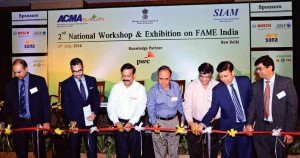The second FAME workshop at Delhi highlighted the need for electric and hybrid vehicles, made sustainable through a collaborative effort.
Story by:
Anirudh Raheja
Automotive Component Manufacturers Association (ACMA) and Society of Indian Automobile Manufacturers (SIAM) joined hands with Ministry of Heavy Industries and Public Enterprises to organise the second national workshop on FAME (Faster Adoption and Manufacturing of Electric Vehicles) at Delhi recently. Aiming to elucidate the roadmap for the auto fraternity to move towards electric mobility, the event saw various stakeholders of the industry discuss about the accomplishments and challenges faced by them. Touching upon the rising pollution levels in cities like Delhi, Mumbai and Bangalore, the workshop highlighted the work being done by the government proactively to ensure an improvement in the air quality. Emphasising the need for hybrid and electric vehicles to improve the air quality, the speakers at the workshop pointed out the challenge of high costs. In his speech, Girish Shankar, Secretary, Ministry of Heavy Industries and Public Enterprises, expressed that over the next 10 years, the industry will witness disruptive changes. “There has to be a collaborative effort to make such (electric) technologies more affordable and create awareness simultaneously,” he mentioned. He opined that there is a need for serious planning on the part of OEMs to address system complexities.
A panel discussion as part of the workshop delved upon the building of a robust electric vehicle supply in the country. The many routes that the government is willing to implement to achieve the same was also highlighted upon during the panel discussion. The panelists called upon the automotive component manufacturers to come up with advanced products. They seemed to be of the opinion collectively that the auto industry should study foreign markets and their successful endeavours to arrive at advanced products. Expressed a panelist that there is a need for technology to move quickly towards a greener future. Senior general manager at Mahindra Reva, Pawan Sachdeva expressed that in China almost 50 per cent of the cost of green vehicles is accounted against the incentives given by the government.
An exhibition organised during the course of the workshop saw auto component manufacturers showcase their capabilities pertaining to electric mobility and highlight the opportunities for localisation. JBM Solaris displayed its low floor nine-metre ECOlife bus, making it clear once again that it intends to manufacture it locally. The Schaeffler Group displayed components that it manufactures, and which find use in electric axles and hybrid modules aimed at the Indian market. Green Fuel Energy showcased a Lithium-ion battery system that it has developed. It can be customised as per the requirement of the user.
Launched last year under the Electric Mobility Mission Plan (NEMP) to offer incentives to manufacturers who undertake the task of manufacturing electric and hybrid vehicles, FAME has been instrumental in garnering a positive opinion about such vehicles. This has led to an increase in the acceptance of hybrid and electric models in a manner similar to their rising acceptance in other parts of the world. Experts at the workshop expressed a need for an ecosystem that would fully support the development of a robust infrastructure. To ensure this, a syndicate, xEV One, has been formed. It comprises of ARAI, SIAM, Maruti Suzuki, Tata Motors, Mahindra and Mahindra, Ford India and Mahindra Reva. Drawing attention to the government allocation of Rs.795 crore over the last two financial years, FY16 and FY17, marking phase one, an industry expert claimed that the second phase would focus on four basic functions – pilot projects, demand creation, technological development and supporting charging infrastructure. Expressed Kavan Mukhtyar, Partner, PwC India, that partnership with research institutions and academia like ARAI and IIT can facilitate experimentation and access to technology.” “It is important to get the right business model and strategies since the adoption of electric vehicles is a challenge. Not just technically, but also economically,” he added. Stressing upon economic feasibility because of low volumes, Muthtyar mentioned, “If we can localise Lithium-ion cell manufacturing it can prove to be a real driving force for the industry to take it to the next level.” Sohinder Gill, Director, Society of Manufacturers of Electric Vehicles, pointed out during his speech that there are certain challenges when it comes to lead acid batteries. “Their charge range goes down in propertion to their use,” he mentioned. Emphasising on the need to develop advanced products locally, Gill opined, “Neither the industry has turned up with better products, nor have we seen much progress in the financing of such vehicles.”
Under the FAME initiative, the total xEV sales are expected to reach a level of seven million units per annum by 2020. This, feel industry experts, would lead to a cummulative saving of about 9500 million litres of fuel and reduction of green house gases by nearly two million tonnes. Expressed a representative of the Department of Heavy Industries, that they are already in talks with oil companies, state governments and municipal corporations for the provision of charging infrastructure. The response has been positive, and standards would soon be set. Apart from setting up of the standards, over 25 hybrid buses are set to find their way to MMRDA in Mumbai. Five hybrid buses are set to find their way to Navi Mumbai. Over 25 fully electric buses are set to find their way to Himachal Pradesh. Another 50 (five-to-six seater) vehicles are set to find their way to HP government. These have been sanctioned by Department of Heavy Industries under various projects. There’s a long way to go yet, and this was aptly highlighted across various discussions during the workshop. A demand for tax reduction for zero-emission fleet also attracted attention. The workshop also highlighted the fact that the benefits from the states to support electric infrastructure are growing.






















